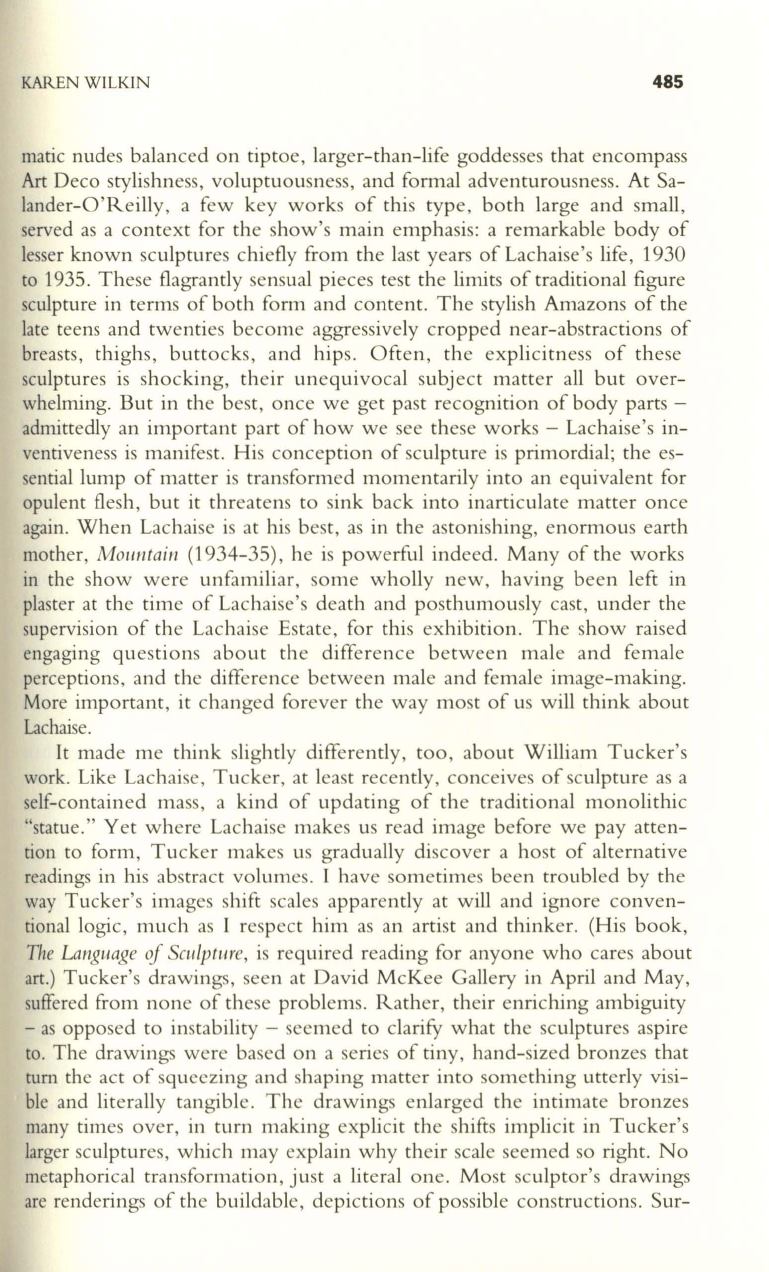
KAREN WILKIN
485
matic nudes balanced on tiptoe, larger-than-life goddesses that encompass
Art Deco stylishness, voluptuousness, and formal adventurousness. At Sa–
lander-O'Reilly, a few key works of this type , both large and small,
served as a context for the show's main emphasis: a remarkable body of
lesser known sculptures chiefly from the last years of Lachaise's life, 1930
to 1935. These flagrantly sensual pieces test the limits of traditional figure
sculpture in terms of both form and content. The stylish Amazons of the
late teens and twenties become aggressively cropped near-abstractions of
breasts, thighs, buttocks, and hips. Often, the explicitness of these
sculptures is shocking, their unequivocal subject matter all but over–
whelming. But in the best, once we get past recognition of body parts -
admittedly an important part of how we see these works - Lachaise's in–
ventiveness is manifest. His conception of sculpture is primordial; the es–
sentiallump of matter is transformed momentarily into an equivalent for
opulent flesh, but it threatens to sink back into inarticulate matter once
again. When Lachaise is at his best, as in the astonishing, enormous earth
mother,
MOlllltaill
(1934-35), he is powerful indeed. Many of the works
in the show were unfamiliar, some wholly new, having been left in
plaster at the time of Lachaise's death and posthumously cast, under the
supervision of the Lachaise Estate, for this exhibition. The show raised
engaging questions about the difference between male and female
perceptions, and the difference between male and female image-making.
More important, it changed forever the way most of us will think about
Lachaise.
It made me think slightly differently, too, about William Tucker's
work. Like Lachaise, Tucker, at least recently , conceives of sculpture as a
self-contained mass, a kind of updating of the traditional monolithic
"statue." Yet where Lachaise makes us read image before we pay atten–
tion to form, Tucker makes us gradually discover a host of alternative
readings in his abstract volumes. I have sometimes been troubled by the
way Tucker's images shift scales apparently at will and ignore conven–
tional logic, much as I respect him as an artist and thinker. (His book,
The Language of Swiptllre,
is required reading for anyone who cares about
art.) Tucker's drawings, seen at David McKee Gallery in April and May,
suffered from none of these problems. Rather, their enriching ambiguity
- as opposed to instability - seemed to clarify what the sculptures aspire
to. The drawings were based on a series of tiny, hand-sized bronzes that
tum the act of squeezing and shaping matter into something utterly visi–
ble and literally tangible . The drawings enlarged the intimate bronzes
many times over, in turn making explicit the shifts implicit in Tucker's
larger sculptures, which may explain why their scale seemed so right. No
metaphorical transformation, just a literal one. Most sculptor's drawings
are renderings of the buildable, depictions of possible constructions. Sur-


